I've got a mostly cosmetic problem. I'm creating four plots using the ggplot2 library that I then arrange in one column (using this). The graphs display the same data but for four groups, the x-axis is time which is why I want to keep the graphs in one single column.
So I add the legend to the top graph, and the labels for the x-axis to the bottom graph. These two actions change the size of the graph; adding a legend causes the graph to grow, adding the x-axis labels causes it to shrink to accomodate these things.
Is there a way to specify a fixed graph size, that would make my layout consistent?
My plot:

Code for reproducible results:
library(ggplot2)
library(reshape)
raw_data <- structure(list(Sample = c(1L, 2L, 3L, 4L, 5L, 6L, 7L, 8L, 9L,
10L, 11L, 12L, 13L, 14L, 15L, 16L, 17L, 18L, 19L, 20L, 21L, 22L,
23L, 24L, 25L, 26L, 1L, 2L, 3L, 4L, 5L, 6L, 7L, 8L, 9L, 10L,
11L, 12L, 13L, 14L, 15L, 16L, 17L, 18L, 19L, 20L, 21L, 22L, 23L,
24L, 25L, 26L), Month = structure(c(12L, 12L, 11L, 11L, 10L,
10L, 3L, 3L, 5L, 5L, 4L, 4L, 8L, 8L, 1L, 1L, 9L, 9L, 7L, 7L,
6L, 6L, 2L, 2L, 12L, 12L, 12L, 12L, 11L, 11L, 10L, 10L, 3L, 3L,
5L, 5L, 4L, 4L, 8L, 8L, 1L, 1L, 9L, 9L, 7L, 7L, 6L, 6L, 2L, 2L,
12L, 12L), .Label = c("April", "Aug", "Dec", "Feb", "Jan", "July",
"June", "March", "May", "Nov", "Oct", "Sep"), class = "factor"),
Channel = structure(c(1L, 1L, 1L, 1L, 1L, 1L, 1L, 1L, 1L,
1L, 1L, 1L, 1L, 1L, 1L, 1L, 1L, 1L, 1L, 1L, 1L, 1L, 1L, 1L,
1L, 1L, 2L, 2L, 2L, 2L, 2L, 2L, 2L, 2L, 2L, 2L, 2L, 2L, 2L,
2L, 2L, 2L, 2L, 2L, 2L, 2L, 2L, 2L, 2L, 2L, 2L, 2L), .Label = c("A",
"B"), class = "factor"), Amplitude = c(5000L,
5000L, 5000L, 5000L, 5000L, 5000L, 5000L, 5000L, 5000L, 5000L, 5000L, 5000L, 5000L,
5000L, 5000L, 5000L, 5000L, 5000L, 5000L, 5000L, 5000L, 5000L, 5000L, 5000L, 5000L, 5000L, 5000L, 5000L,
5000L, 5000L, 5000L, 5000L, 5000L, 5000L, 5000L, 5000L, 5000L, 5000L, 5000L,
5000L, 5000L, 5000L, 5000L, 5000L, 5000L, 5000L, 5000L, 5000L, 5000L, 5000L, 5000L, 5000L)), .Names = c("Sample",
"Month", "Channel", "Amplitude"), row.names = c(NA, 52L), class = "data.frame")
multiplot <- function(..., plotlist=NULL, cols) {
require(grid)
# Make a list from the ... arguments and plotlist
plots <- c(list(...), plotlist)
numPlots = length(plots)
# Make the panel
plotCols = cols # Number of columns of plots
plotRows = ceiling(numPlots/plotCols) # Number of rows needed, calculated from # of cols
# Set up the page
grid.newpage()
pushViewport(viewport(layout = grid.layout(plotRows, plotCols)))
vplayout <- function(x, y) {
viewport(layout.pos.row = x, layout.pos.col = y)
}
# Make each plot, in the correct location
for (i in 1:numPlots) {
curRow = ceiling(i/plotCols)
curCol = (i-1) %% plotCols + 1
print(plots[[i]], vp = vplayout(curRow, curCol))
}
}
mybarplot <- function(first=0, last=0) {
# Create the barplot
p <- ggplot(raw_data, aes(x=Sample, y=Amplitude, fill=Channel))
# Make it a grouped barplot with already summarised values
p <- p + geom_bar(position="dodge", stat="identity")
# Apply a log10 transformation to the y-axis, and create appropriate axis ticks
p <- p + scale_y_log10(breaks = c(5,10,50,100,500,1000,5000,10000))
# Zoom in (barplots will not show when axis change to remove 0, so have to zoom)
p <- p + coord_cartesian(ylim=c(1,15000), xlim=c(1,26))
# Make it greyscale
p <- p + scale_fill_grey()
# Hide X label
p <- p + opts(axis.text.x=theme_blank(), axis.title.x=theme_blank(), axis.title.y=theme_blank())
# Change X label size
p <- p + opts(axis.text.y=theme_text(size=7))
# Change the Legend
p <- p + scale_fill_manual(values=c("black", "grey75", "grey25"), name="Channel", breaks=c("A", "B"))
#margins
# c(top,,bottom,)
top_margin <- unit(c( 1, 1, -0.25, 1), "lines")
middle_margin <- unit(c(-0.25, 1, -0.25, 1), "lines")
bottom_margin <- unit(c(-0.25, 1, 2, 1), "lines")
if (first) {
# Anchor legend box to top right corner
p <- p + opts(legend.justification=c(1,1), legend.position=c(1,1))
# Put a white box around it
p <- p + opts(legend.background = theme_rect(fill="white"))
# Top margin
p <- p + opts(plot.margin = top_margin)
p <- p + scale_x_discrete(breaks = 1:26)
} else {
p <- p + opts(legend.position="none")
if (last) {
# Bottom margin
p <- p + opts(plot.margin = bottom_margin)
# label X-axis
p <- p + scale_x_discrete(breaks = 1:26, labels=c("Sep", "", "Oct", "", "Nov", "", "Dec", "", "Jan", "", "Feb", "", "March", "", "April", "", "May", "", "June", "", "July", "", "Aug", "", "Sep", ""))
p <- p + ylab("Amplitude")
p <- p + xlab("Sampling time")
# Angle x labels
#p <- p + opts(axis.text.x=theme_text(angle=-45, hjust=0.5))
p <- p + opts(axis.text.x=theme_text(hjust=0.5))
# Move X title
p <- p + opts(axis.title.x=theme_text(vjust=-0.5))
} else {
p <- p + opts(plot.margin = middle_margin)
p <- p + scale_x_discrete(breaks = 1:26)
}
}
}
plot1 <- mybarplot(first=1)
plot2 <- mybarplot()
plot3 <- mybarplot()
plot4 <- mybarplot(last=1)
multiplot(plot1, plot2, plot3, plot4, cols=1)
Session info:
> sessionInfo()
R version 2.15.1 (2012-06-22)
Platform: x86_64-apple-darwin9.8.0/x86_64 (64-bit)
locale:
[1] C
attached base packages:
[1] grid stats graphics grDevices utils datasets methods base
other attached packages:
[1] reshape_0.8.4 plyr_1.7.1 ggplot2_0.9.1
loaded via a namespace (and not attached):
[1] MASS_7.3-18 RColorBrewer_1.0-5 colorspace_1.1-1 dichromat_1.2-4 digest_0.5.2 labeling_0.1 memoise_0.1 munsell_0.3 proto_0.3-9.2 reshape2_1.2.1
[11] scales_0.2.1 stringr_0.6.1